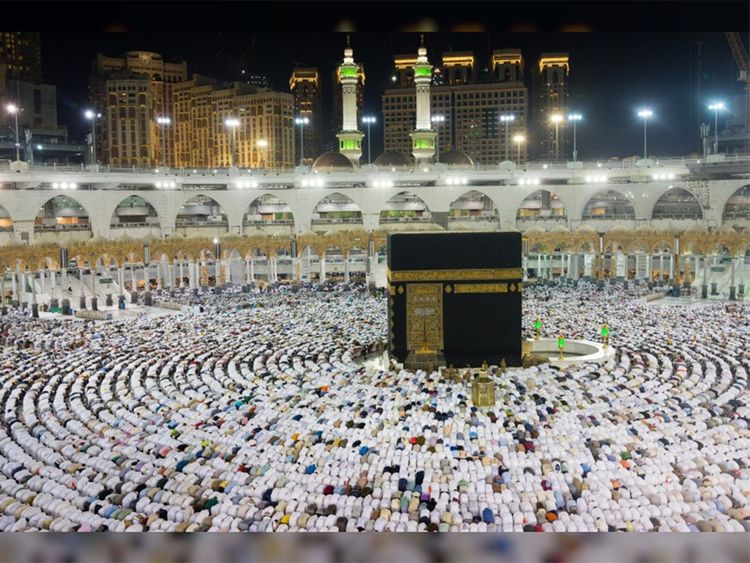Hajj is the name of a pilgrimage to Islamic holy sites in and around Makkah, a city in Saudi Arabia. It is obligatory to perform at least once in a lifetime if a Muslim is physically fit enough and financially able to undertake the journey. The pilgrimage is one of the Five Pillars of Islam and it occurs annually in the Islamic month of Dhul Hija.
How long does Hajj take?
Hajj usually takes around three to five days
When does Hajj start?
Start Date: The eighth day of the lunar month of Dhul-Hijjah (the Gregorian date changes every year).
End Date: The 12th day of Dhul-Hijjah.
Why do so many Muslims take part in Hajj?
Millions of pilgrims from around the world travel to Makkah seeking the blessings of Hajj each year. Muslims believe a successful Hajj brings enormous spiritual rewards and erases all of your previous sins. The pilgrimage is held following the example of Prophet Mohammad, Peace Be Upon Him (PBUH), but Muslims also believe the roots of Hajj date back thousands of years to the time of Prophet Abraham, Peace Be Upon Him (PBUH).
The rituals that are performed are symbolic re-enactments serving as reminders of the sacrifices and obedience of Prophet Abraham. Hajj also seeks to gather Muslims in a spirit of unity and brotherhood.
How do people dress for the occasion?
Men
Male pilgrims first put on the ‘Ihram’, two plain white sheets of cloth that serve as a lower and upper body cover, before they arrive in Mecca. The Ihram helps foster a conviction that all people are equal before God, regardless of their background, wealth or social standing. It also means they are forbidden from certain acts such as fighting or indecency.
Women
Women can wear regular clothes, as long as they are modest, clean and simple. They should cover their hair, but should not cover their faces. A niqab is not allowed during Hajj.
Day 1 of Hajj
After wearing the Ihram (Hajj clothes), the first step is called the “tawaf,” where pilgrims walk around the Kaaba, a stone shrine said to have been built by the Prophet Ibrahim and his son Ismail around 4,000 years ago.
People circle the Kaaba, which is located at the Masjid Al Haram. People usually walk counter-clockwise so that the Kabaa stays at their left. They usually circle the Kabah seven times, praying as they do so. This is the chance for Muslims to pray and ask for what they want in life.
After circling the Kaaba, next, the pilgrims have to perform the ‘Say’a’, which includes walking seven times between two hills known as the Safa and Marwa, which represents Hagar’s (Hajira’s) search for water for her son Ismail. These days, the hills are enclosed within the Masjid Al-Haram complex. The floors are marble and the area is air conditioned. There is even a moving walkway for pilgrims who cannot walk those who cannot walk.
After walking up and down the Safa and Marwa, pilgrims can then travel via a shuttle bus to a small village called Mina. They camp in tents there until morning. During this time, pilgrims will pray, read the Quran and rest.
Day 2 of Hajj
On day two of Hajj, people wake up at dawn and leave their tents to travel to the mountain of Arafat to perform ‘Wuquf’. This is performed on Arafat Day, the day before the first day of Eid Al Adha. Arafat is where Prophet Mohammad delivered his famous last sermon. The day is called Wuquf (standing) because the pilgrims spend the whole day standing (if they are able) near the Arafat mountain. Pilgrims stay put till around sunset. They spend the day praying for forgiveness and wellbeing. After that, they move on to Muzdalifah to pray the sunset and night prayers.
Day 3 of Hajj
In the morning, pilgrims spend a few minutes gathering pebbles, to use for the “stoning” ceremony later in the day. Then the pilgrims return to Mina. That is where the stoning takes place in the Mina area where, pilgrims throw seven pebbles each at a stone monument called the Jamrat Al Aqabah. This symbolises resisting the temptation of the devil.
Pilgrims are then supposed to sacrifice an animal in gratitude. These days, however, many people just purchase a sacrifice voucher. This vouchers signify that an animal was sacrificed in your name.
Then pilgrims are supposed to cut or shave their hair. Men are encouraged to shave while women only cut a small lock of hair.
After that, they return to Makkah once again to circle the Kaab’aa and walk between Safa and Marwah. Pilgrims are also encouraged to drink from the ancient spring known as Zamzam.
The Zamzam water is brought from the well of Zamzam, purified, cooled, and pumped into the Mosque via a tap. Hajj is now complete.
(with inputs from Gulf News)









Comment